Between 2575 and 2465 B.C.E., the Pyramids of Giza were constructed as tombs for the pharaohs Khufu, Khafre, and Menkaure — but who built the pyramids?
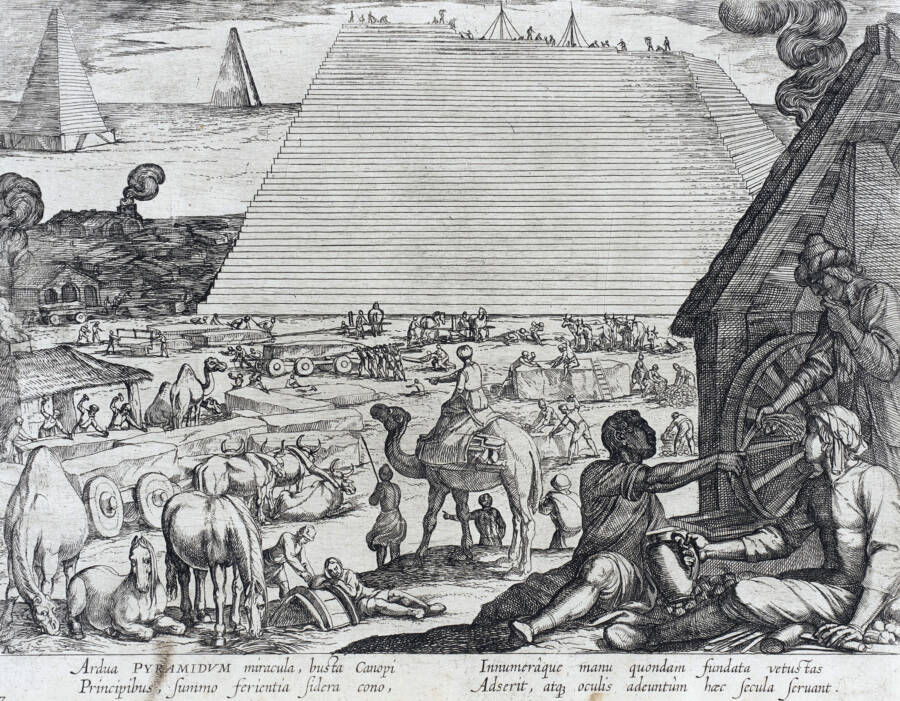
Science History Images/Alamy Stock PhotoMany people believe the pyramids were built by enslaved Jewish laborers — but they were actually constructed by a skilled group of workers.
There is no short supply of theories about who built the pyramids. Many suggest that slaves kept by the ancient Egyptians were forced en masse to construct these magnificent ancient wonders. Other, more outlandish, theories claim that the Pyramids of Giza were erected by aliens.
Certainly, the pyramids are a remarkable feat of architectural engineering — one that would be difficult even today. It’s easy to see why conspiracy theories about aliens or Atlanteans are so popular given the intricate design of these grand monuments.
The most popular belief is that the pyramids were constructed by enslaved workers. However, evidence shows that it was actually a relatively small group of skilled laborers who built the pyramids — so why have their stories seemingly been erased in favor of these other theories? This is the real history behind who built the pyramids of ancient Egypt.
The Mystery Behind Who Built The Pyramids
Egypt is all but synonymous with pyramids, given that more than 100 of the ancient structures dot the country’s landscape. The first, and largest, was the Pyramid of Djoser. Construction of the tomb began around 2667 B.C.E.
However, when most people think of Egyptian pyramids, the Pyramids of Giza come to mind. These monuments were constructed during the reigns of the pharaohs Khufu, Khafre, and Menkaure between around 2575 and 2465 B.C.E.
The pyramids have remained a fixture in the minds of historians, architects, and conspiracy theorists alike for thousands of years, largely because they are extraordinarily complex and structurally sound, even by modern standards. Given that the ancient Egyptians lacked many of the more modern tools that would have aided in the pyramids’ construction — including the wheel — it is even more impressive that these massive structures have stood the test of time. And the story of who built the pyramids explains a lot about their durability.
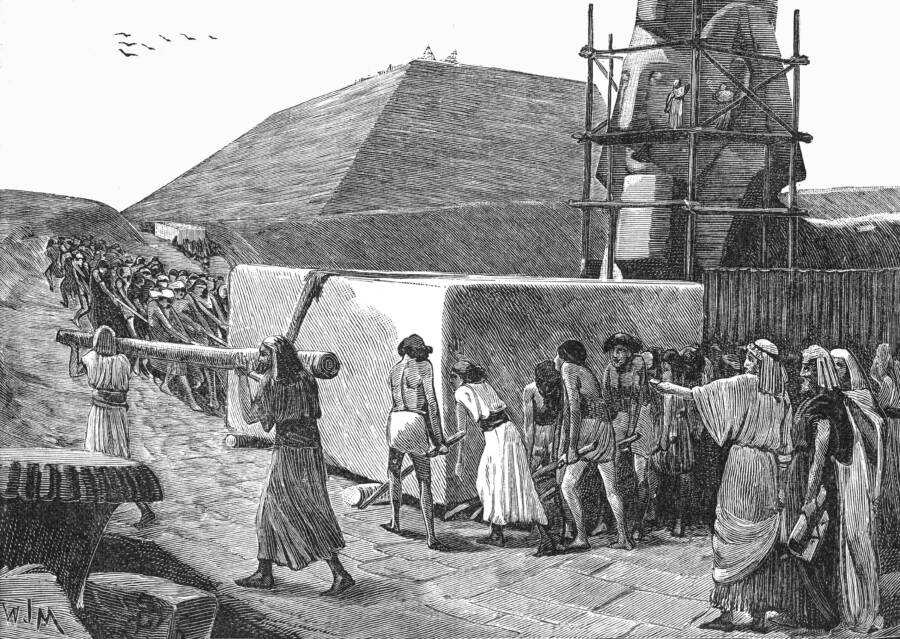
De Luan/Alamy Stock PhotoConstructing a pyramid involved moving huge quantities of stone. Evidence indicates that massive limestone blocks were transported along the Nile.
For centuries, how the pyramids were built was a mystery in its own right, but evidence discovered in recent years has shed some light on how, exactly, ancient laborers were able to move giant stones across the desert and lift them to the top of the ever-growing pyramids. The answer, it turned out, was fairly simple yet ingenious — and involved a lot of water.
Popular media, meanwhile, continued to put forth the idea that the pyramids were built by enslaved Jewish workers who were forced to do backbreaking, deadly labor that led thousands to die in involuntary servitude.
It wasn’t a new idea, either. In fact, this theory about who built the pyramids was initially put forth by the Greek historian Herodotus, who is sometimes referred to as “the father of history.” However, Herodotus was also known to exaggerate his stories — or even make them up entirely — also earning him the name “the father of lies.”
Still, his suggestion that slaves built the pyramids was believed to be fact for thousands of years, and it was only recently that researchers discovered he was wrong.
Did Enslaved Workers Build The Pyramids?
Excavations in the 1990s into what researchers sometimes call “pyramid city” were crucial in establishing a modern understanding of not just how the pyramids were built but also by whom.
Specifically, it was the discovery of large quantities of animal bones belonging to young cows, sheep, and goats that sowed the first seeds of doubt on the slave theory of who built the pyramids. The presence of these bones suggested that meals of prime beef and other valuable meats had been consumed by those who worked on the pyramids, foods that enslaved laborers would not have had the opportunity to eat.
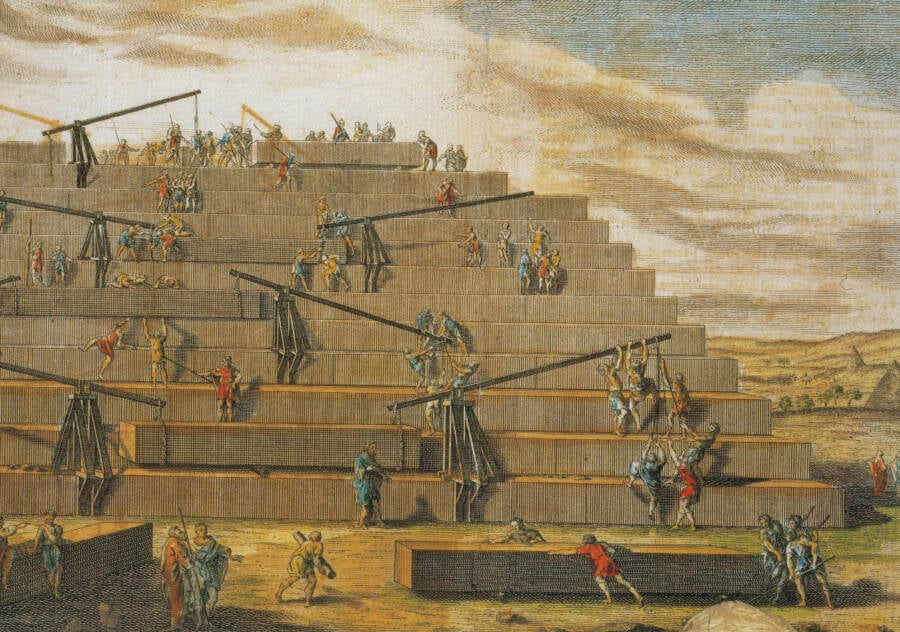
Science History Images/Alamy Stock PhotoA 1759 lithograph illustrating Herodotus’ theory of how the pyramids were built.
It’s also important to note that archaeologists have never found evidence of Jewish enslavement in ancient Egypt. According to Discover Magazine, this idea is a Judeo-Christian narrative that first appeared in the book of Exodus with the story of Moses. While Hollywood films have continued to spread this idea, Egypt has repeatedly claimed it’s a historical inaccuracy.
Archaeologists have also unearthed the remains of various barracks at the Giza pyramid complex, many of which were equipped with a number of conveniences. Again, these barracks were simply too nice to have been made for enslaved workers. Rather, they were likely used by a series of skilled laborers, some of whom were buried in a large graveyard at the complex.

Morhaf Kamal Aljanee/Wikimedia CommonsThe Pyramids at Giza.
The evidence of a graveyard itself also helps to disprove the slave theory purporting to explain who built the pyramids. If skilled laborers were dying on the job, it was surely dangerous work. Adding unskilled laborers into the mix would only have been more detrimental.
Some of the workers’ remains also showed that they had healed bones, which suggests that they had some access to medical care at the site as well. All of these factors in combination have led modern Egyptologists to generally agree that those who built the pyramids were voluntary, skilled laborers who were treated fairly well — and likely compensated well, too.
Still, there are many unanswered questions about the pyramids that continue to baffle historians to this day.
Unanswered Questions About The Construction Of Egypt’s Pyramids
While historians now generally agree that a group of skilled laborers constructed the pyramids, the exact number of workers involved remains unclear. Some estimates suggest as few as 20,000 workers came together to build the pyramids, while others place the number upwards of 100,000.
Researchers have theorized that some of the supplies used for building the pyramids came from hundreds or even thousands of miles away and were likely transported down manmade channels branching off of the Nile River. This included granite from Aswan quarries, tools to cut copper transported from the Sinai Peninsula, and timber brought in from Lebanon. They even transported livestock — which was slaughtered en masse to feed the workers — via these same channels.
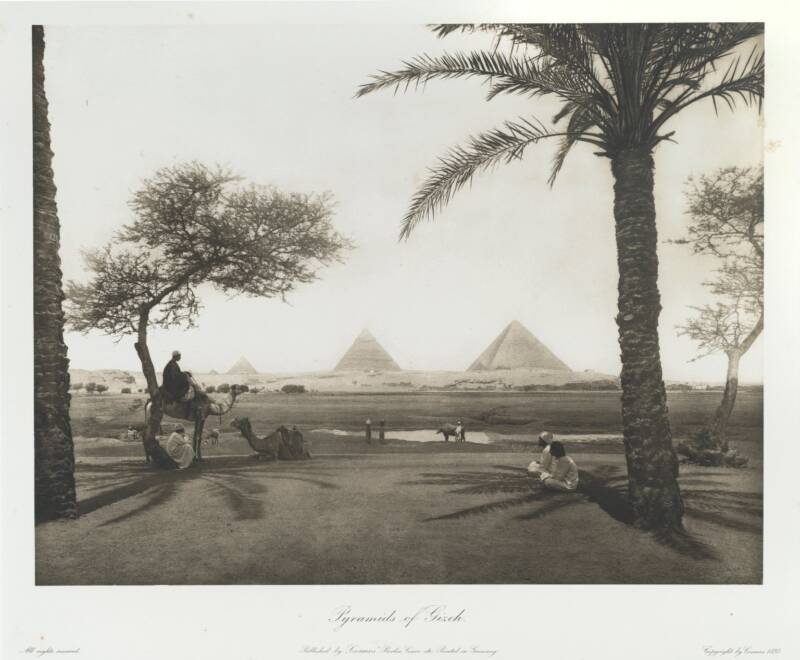
R.M. Junghaendel / Brooklyn Museum / Wikimedia CommonsPyramids of Ghizeh. 1893.
Others noted ancient depictions of workers moving stones across the desert, a task that seemed all but impossible except for one tiny detail: a leader at the front of the group pouring water onto the sand. Researchers have suggested that wetting a path ahead of the stone may have enabled these blocks to be moved with relative ease.
So, historians now have some understanding of how these massive pieces of stone and thousands of tools may have been transported — but the exact nature of how the ancients went about building the pyramids is still unclear.
Some experts, including Egyptologist Mark Lehner, have suggested the ancient laborers who built the pyramids used ramps — either built into the pyramids themselves or assembled on the outside — to gradually move stone blocks into place.
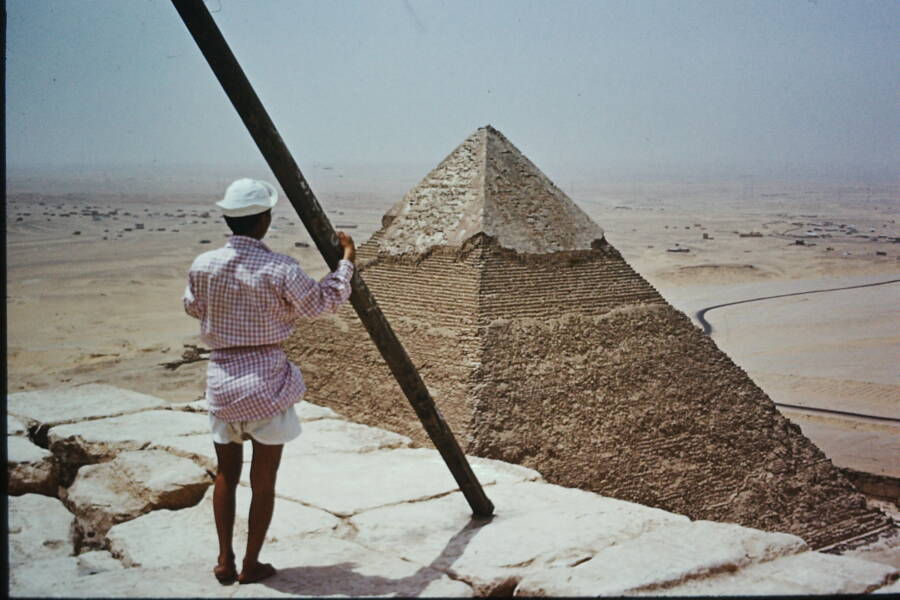
Wikimedia CommonsThe view from the top of the Great Pyramid. 1972.
There are several groups who are trying to find answers to these questions. The ScanPyramids project, for example, is an international team operating under the authority of Egypt’s Ministry of Antiquities. They hope to use modern technology to explore the internal layout of the pyramids without having to actually go inside.
Similar technology has also unveiled a number of large, seemingly empty spaces inside the pyramids, all of which appear to have served no ritual purpose. It’s possible they were used to help with the pyramids’ structural integrity or for more specific engineering purposes, but for the moment, little else is known about them.
In any case, Egypt’s pyramids have remained a point of fascination for more than 4,000 years — and that seems unlikely to change any time soon, even if the story of who built the pyramids remains relatively little-known and often shrouded in falsehoods.
After reading about who built the pyramids, learn all about the Nubian pyramids of Sudan. Then, discover the story of Newgrange, the massive Irish tomb that’s even older than the Egyptian pyramids.





